Therapeutic Relationships in Nursing: A Case Study Analysis
VerifiedAdded on 2023/06/13
|7
|1778
|126
Essay
AI Summary
This essay discusses the importance of developing therapeutic relationships between healthcare professionals and patients, emphasizing cultural sensitivity and competence. It uses a case study of Bruce, an Aboriginal man, to illustrate how nurses can build trust and rapport through effective communication, person-centered care, and proper documentation. The essay highlights the significance of understanding cultural nuances in communication, such as eye contact and direct questioning, to avoid causing offense or disrespect. It also underscores the role of thorough documentation in ensuring continuity of care and preventing legal issues. Furthermore, the essay advocates for a person-centered approach that prioritizes the patient's preferences and involves them in decision-making regarding their health. The essay concludes by emphasizing the need for healthcare professionals to adopt culturally competent communication skills, effective documentation practices, and a person-centered approach to provide high-quality care and improve patient outcomes.
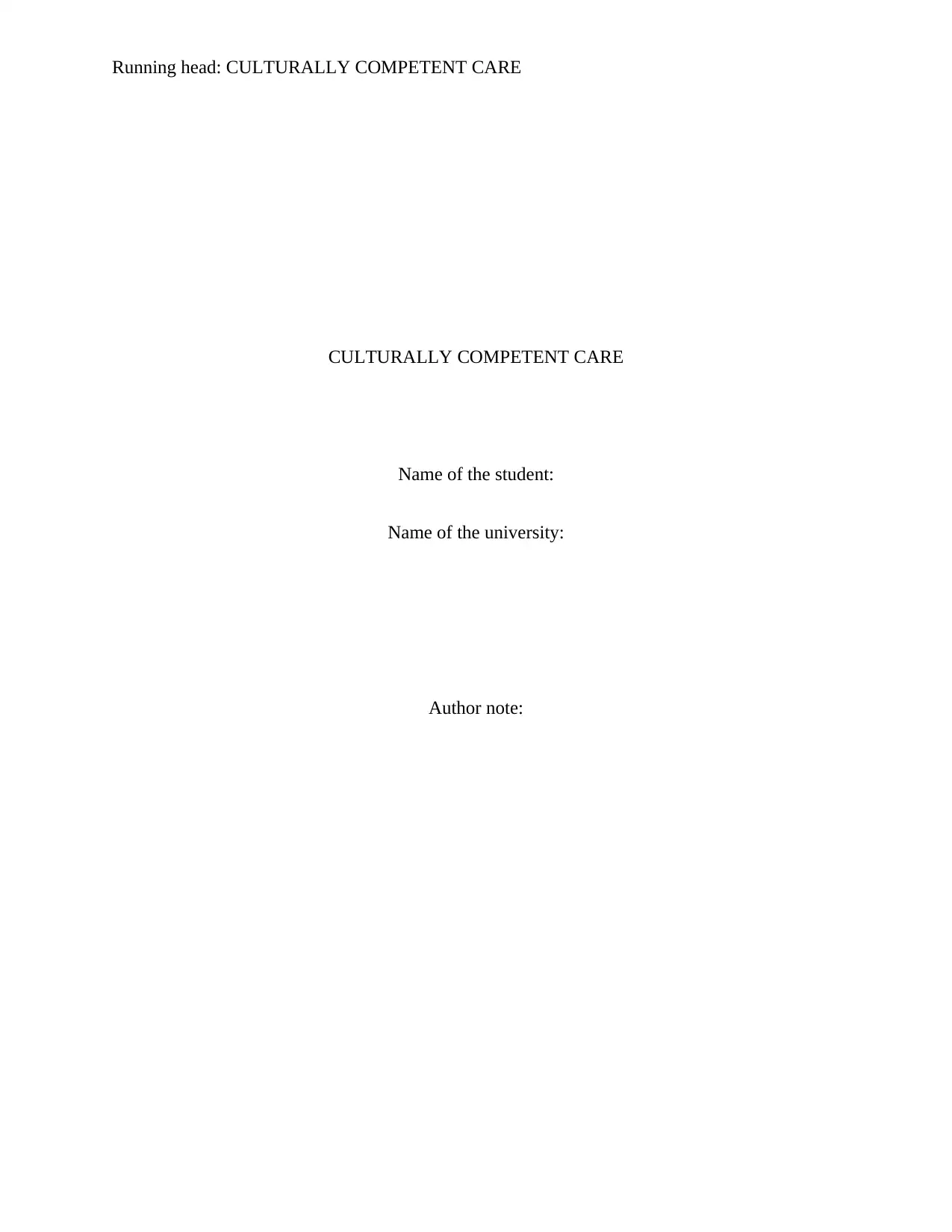
Running head: CULTURALLY COMPETENT CARE
CULTURALLY COMPETENT CARE
Name of the student:
Name of the university:
Author note:
CULTURALLY COMPETENT CARE
Name of the student:
Name of the university:
Author note:
Paraphrase This Document
Need a fresh take? Get an instant paraphrase of this document with our AI Paraphraser
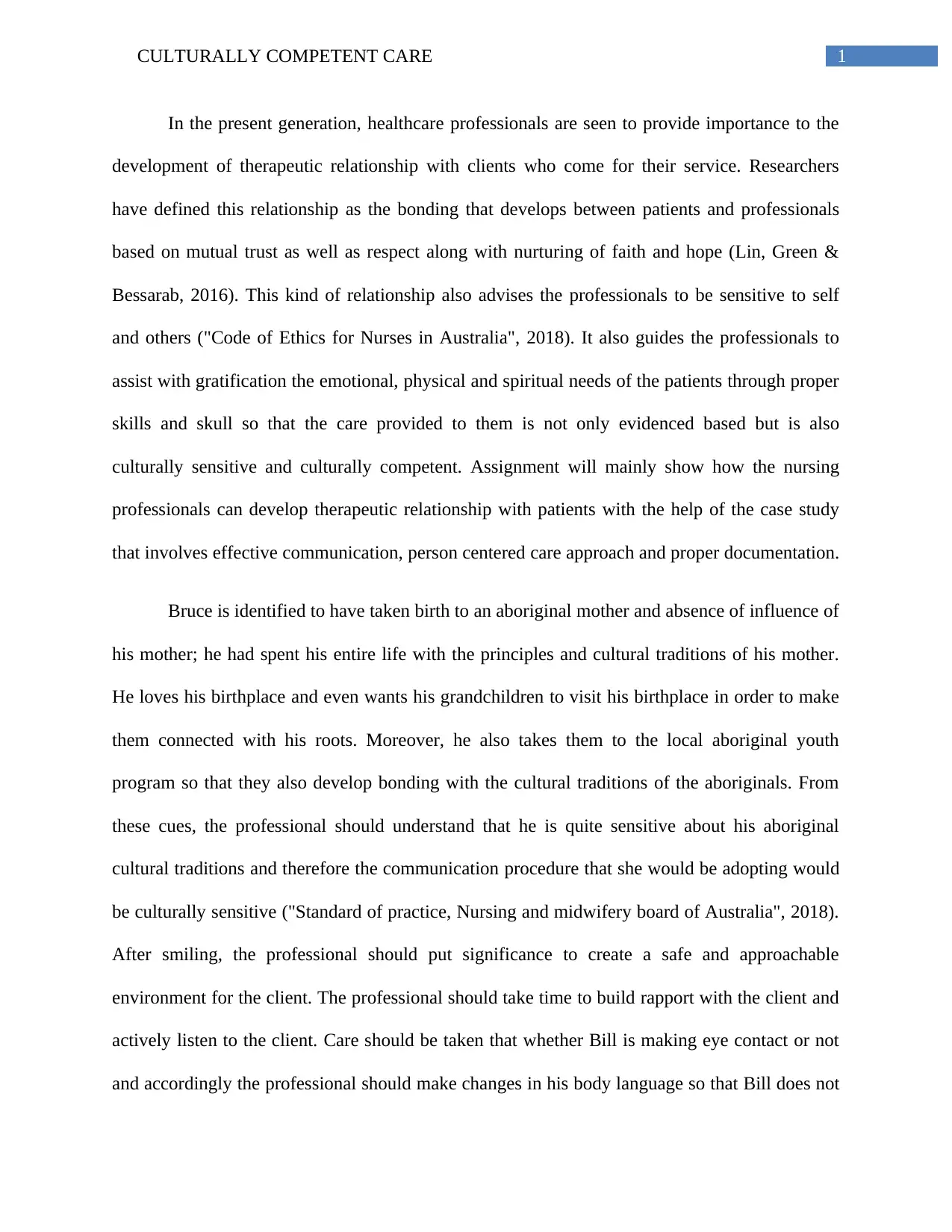
1CULTURALLY COMPETENT CARE
In the present generation, healthcare professionals are seen to provide importance to the
development of therapeutic relationship with clients who come for their service. Researchers
have defined this relationship as the bonding that develops between patients and professionals
based on mutual trust as well as respect along with nurturing of faith and hope (Lin, Green &
Bessarab, 2016). This kind of relationship also advises the professionals to be sensitive to self
and others ("Code of Ethics for Nurses in Australia", 2018). It also guides the professionals to
assist with gratification the emotional, physical and spiritual needs of the patients through proper
skills and skull so that the care provided to them is not only evidenced based but is also
culturally sensitive and culturally competent. Assignment will mainly show how the nursing
professionals can develop therapeutic relationship with patients with the help of the case study
that involves effective communication, person centered care approach and proper documentation.
Bruce is identified to have taken birth to an aboriginal mother and absence of influence of
his mother; he had spent his entire life with the principles and cultural traditions of his mother.
He loves his birthplace and even wants his grandchildren to visit his birthplace in order to make
them connected with his roots. Moreover, he also takes them to the local aboriginal youth
program so that they also develop bonding with the cultural traditions of the aboriginals. From
these cues, the professional should understand that he is quite sensitive about his aboriginal
cultural traditions and therefore the communication procedure that she would be adopting would
be culturally sensitive ("Standard of practice, Nursing and midwifery board of Australia", 2018).
After smiling, the professional should put significance to create a safe and approachable
environment for the client. The professional should take time to build rapport with the client and
actively listen to the client. Care should be taken that whether Bill is making eye contact or not
and accordingly the professional should make changes in his body language so that Bill does not
In the present generation, healthcare professionals are seen to provide importance to the
development of therapeutic relationship with clients who come for their service. Researchers
have defined this relationship as the bonding that develops between patients and professionals
based on mutual trust as well as respect along with nurturing of faith and hope (Lin, Green &
Bessarab, 2016). This kind of relationship also advises the professionals to be sensitive to self
and others ("Code of Ethics for Nurses in Australia", 2018). It also guides the professionals to
assist with gratification the emotional, physical and spiritual needs of the patients through proper
skills and skull so that the care provided to them is not only evidenced based but is also
culturally sensitive and culturally competent. Assignment will mainly show how the nursing
professionals can develop therapeutic relationship with patients with the help of the case study
that involves effective communication, person centered care approach and proper documentation.
Bruce is identified to have taken birth to an aboriginal mother and absence of influence of
his mother; he had spent his entire life with the principles and cultural traditions of his mother.
He loves his birthplace and even wants his grandchildren to visit his birthplace in order to make
them connected with his roots. Moreover, he also takes them to the local aboriginal youth
program so that they also develop bonding with the cultural traditions of the aboriginals. From
these cues, the professional should understand that he is quite sensitive about his aboriginal
cultural traditions and therefore the communication procedure that she would be adopting would
be culturally sensitive ("Standard of practice, Nursing and midwifery board of Australia", 2018).
After smiling, the professional should put significance to create a safe and approachable
environment for the client. The professional should take time to build rapport with the client and
actively listen to the client. Care should be taken that whether Bill is making eye contact or not
and accordingly the professional should make changes in his body language so that Bill does not
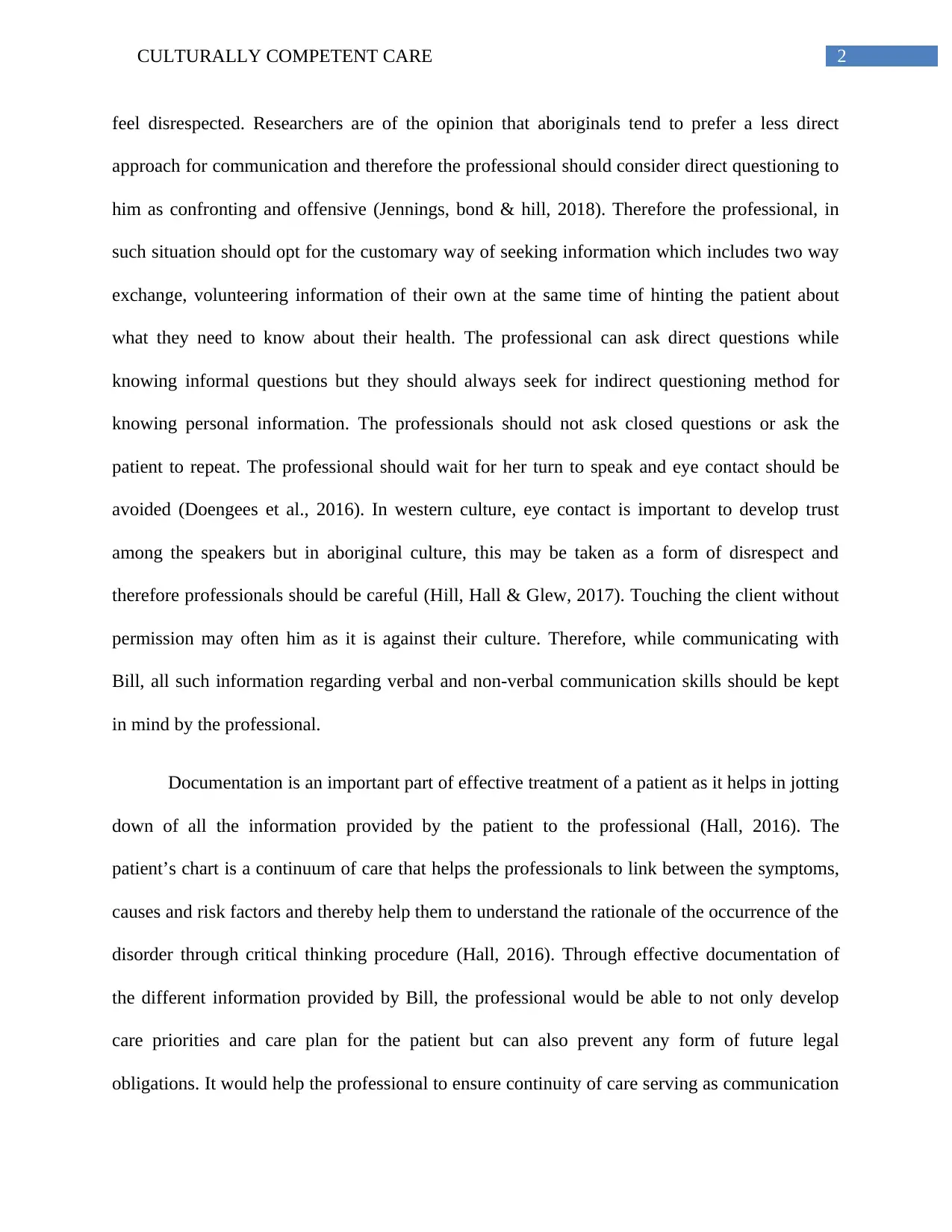
2CULTURALLY COMPETENT CARE
feel disrespected. Researchers are of the opinion that aboriginals tend to prefer a less direct
approach for communication and therefore the professional should consider direct questioning to
him as confronting and offensive (Jennings, bond & hill, 2018). Therefore the professional, in
such situation should opt for the customary way of seeking information which includes two way
exchange, volunteering information of their own at the same time of hinting the patient about
what they need to know about their health. The professional can ask direct questions while
knowing informal questions but they should always seek for indirect questioning method for
knowing personal information. The professionals should not ask closed questions or ask the
patient to repeat. The professional should wait for her turn to speak and eye contact should be
avoided (Doengees et al., 2016). In western culture, eye contact is important to develop trust
among the speakers but in aboriginal culture, this may be taken as a form of disrespect and
therefore professionals should be careful (Hill, Hall & Glew, 2017). Touching the client without
permission may often him as it is against their culture. Therefore, while communicating with
Bill, all such information regarding verbal and non-verbal communication skills should be kept
in mind by the professional.
Documentation is an important part of effective treatment of a patient as it helps in jotting
down of all the information provided by the patient to the professional (Hall, 2016). The
patient’s chart is a continuum of care that helps the professionals to link between the symptoms,
causes and risk factors and thereby help them to understand the rationale of the occurrence of the
disorder through critical thinking procedure (Hall, 2016). Through effective documentation of
the different information provided by Bill, the professional would be able to not only develop
care priorities and care plan for the patient but can also prevent any form of future legal
obligations. It would help the professional to ensure continuity of care serving as communication
feel disrespected. Researchers are of the opinion that aboriginals tend to prefer a less direct
approach for communication and therefore the professional should consider direct questioning to
him as confronting and offensive (Jennings, bond & hill, 2018). Therefore the professional, in
such situation should opt for the customary way of seeking information which includes two way
exchange, volunteering information of their own at the same time of hinting the patient about
what they need to know about their health. The professional can ask direct questions while
knowing informal questions but they should always seek for indirect questioning method for
knowing personal information. The professionals should not ask closed questions or ask the
patient to repeat. The professional should wait for her turn to speak and eye contact should be
avoided (Doengees et al., 2016). In western culture, eye contact is important to develop trust
among the speakers but in aboriginal culture, this may be taken as a form of disrespect and
therefore professionals should be careful (Hill, Hall & Glew, 2017). Touching the client without
permission may often him as it is against their culture. Therefore, while communicating with
Bill, all such information regarding verbal and non-verbal communication skills should be kept
in mind by the professional.
Documentation is an important part of effective treatment of a patient as it helps in jotting
down of all the information provided by the patient to the professional (Hall, 2016). The
patient’s chart is a continuum of care that helps the professionals to link between the symptoms,
causes and risk factors and thereby help them to understand the rationale of the occurrence of the
disorder through critical thinking procedure (Hall, 2016). Through effective documentation of
the different information provided by Bill, the professional would be able to not only develop
care priorities and care plan for the patient but can also prevent any form of future legal
obligations. It would help the professional to ensure continuity of care serving as communication
⊘ This is a preview!⊘
Do you want full access?
Subscribe today to unlock all pages.

Trusted by 1+ million students worldwide
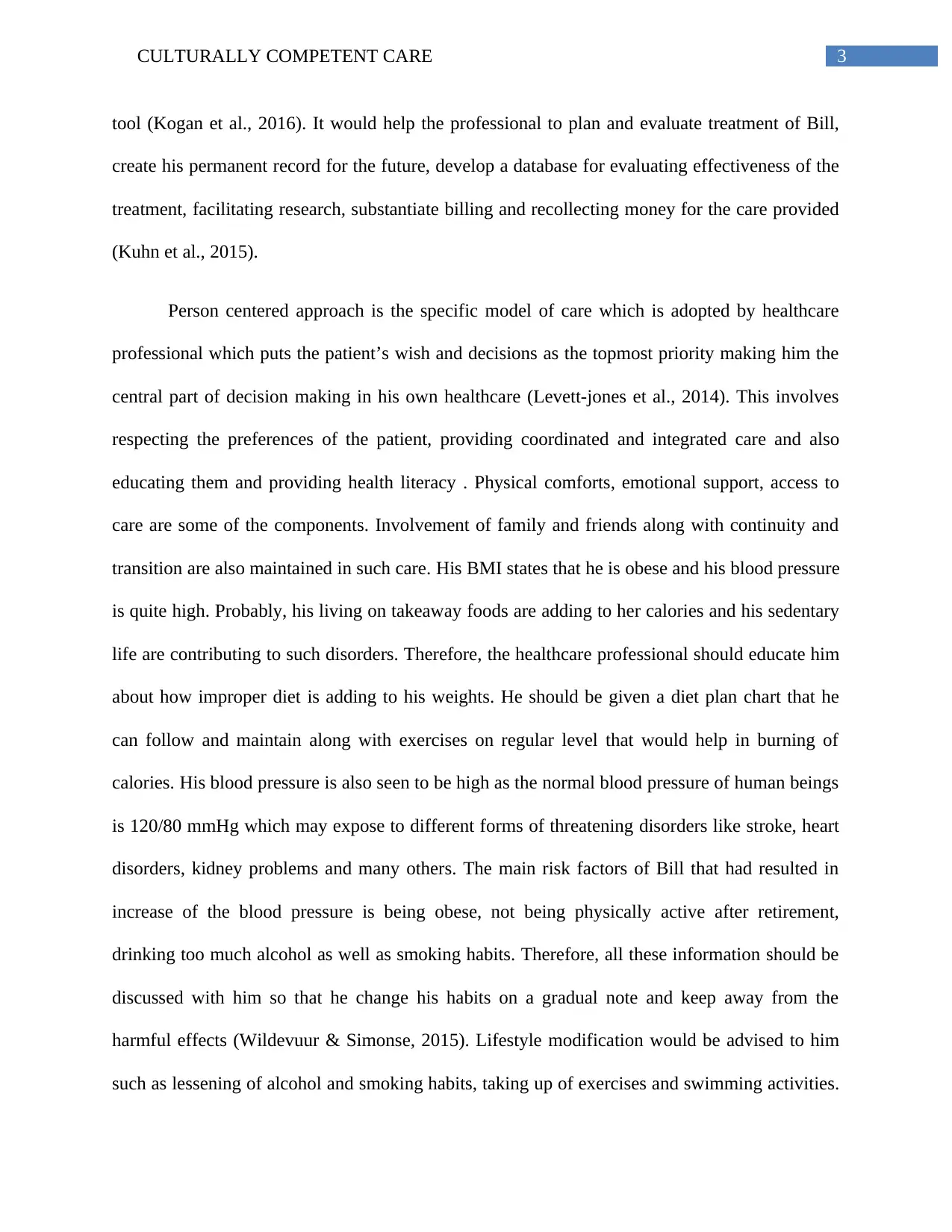
3CULTURALLY COMPETENT CARE
tool (Kogan et al., 2016). It would help the professional to plan and evaluate treatment of Bill,
create his permanent record for the future, develop a database for evaluating effectiveness of the
treatment, facilitating research, substantiate billing and recollecting money for the care provided
(Kuhn et al., 2015).
Person centered approach is the specific model of care which is adopted by healthcare
professional which puts the patient’s wish and decisions as the topmost priority making him the
central part of decision making in his own healthcare (Levett-jones et al., 2014). This involves
respecting the preferences of the patient, providing coordinated and integrated care and also
educating them and providing health literacy . Physical comforts, emotional support, access to
care are some of the components. Involvement of family and friends along with continuity and
transition are also maintained in such care. His BMI states that he is obese and his blood pressure
is quite high. Probably, his living on takeaway foods are adding to her calories and his sedentary
life are contributing to such disorders. Therefore, the healthcare professional should educate him
about how improper diet is adding to his weights. He should be given a diet plan chart that he
can follow and maintain along with exercises on regular level that would help in burning of
calories. His blood pressure is also seen to be high as the normal blood pressure of human beings
is 120/80 mmHg which may expose to different forms of threatening disorders like stroke, heart
disorders, kidney problems and many others. The main risk factors of Bill that had resulted in
increase of the blood pressure is being obese, not being physically active after retirement,
drinking too much alcohol as well as smoking habits. Therefore, all these information should be
discussed with him so that he change his habits on a gradual note and keep away from the
harmful effects (Wildevuur & Simonse, 2015). Lifestyle modification would be advised to him
such as lessening of alcohol and smoking habits, taking up of exercises and swimming activities.
tool (Kogan et al., 2016). It would help the professional to plan and evaluate treatment of Bill,
create his permanent record for the future, develop a database for evaluating effectiveness of the
treatment, facilitating research, substantiate billing and recollecting money for the care provided
(Kuhn et al., 2015).
Person centered approach is the specific model of care which is adopted by healthcare
professional which puts the patient’s wish and decisions as the topmost priority making him the
central part of decision making in his own healthcare (Levett-jones et al., 2014). This involves
respecting the preferences of the patient, providing coordinated and integrated care and also
educating them and providing health literacy . Physical comforts, emotional support, access to
care are some of the components. Involvement of family and friends along with continuity and
transition are also maintained in such care. His BMI states that he is obese and his blood pressure
is quite high. Probably, his living on takeaway foods are adding to her calories and his sedentary
life are contributing to such disorders. Therefore, the healthcare professional should educate him
about how improper diet is adding to his weights. He should be given a diet plan chart that he
can follow and maintain along with exercises on regular level that would help in burning of
calories. His blood pressure is also seen to be high as the normal blood pressure of human beings
is 120/80 mmHg which may expose to different forms of threatening disorders like stroke, heart
disorders, kidney problems and many others. The main risk factors of Bill that had resulted in
increase of the blood pressure is being obese, not being physically active after retirement,
drinking too much alcohol as well as smoking habits. Therefore, all these information should be
discussed with him so that he change his habits on a gradual note and keep away from the
harmful effects (Wildevuur & Simonse, 2015). Lifestyle modification would be advised to him
such as lessening of alcohol and smoking habits, taking up of exercises and swimming activities.
Paraphrase This Document
Need a fresh take? Get an instant paraphrase of this document with our AI Paraphraser
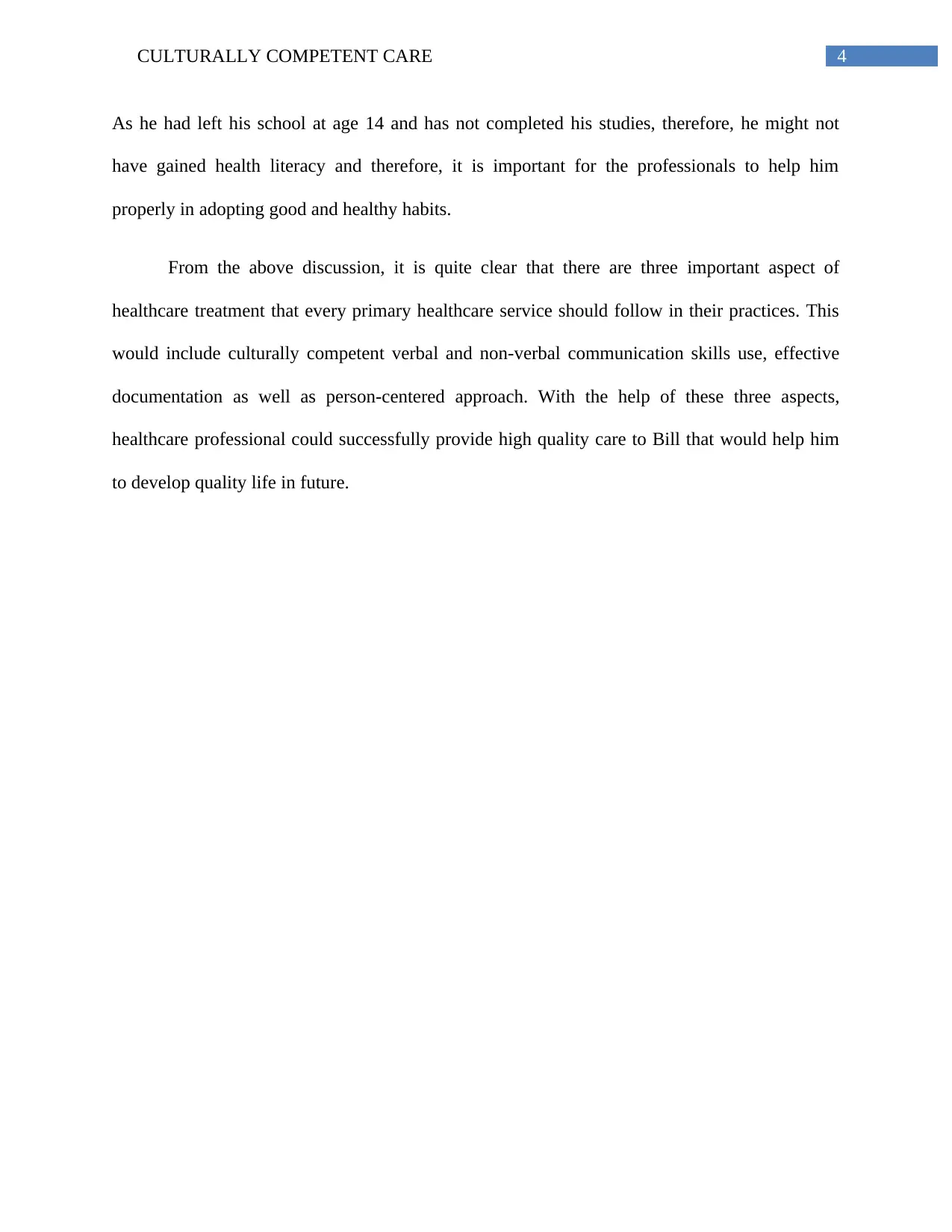
4CULTURALLY COMPETENT CARE
As he had left his school at age 14 and has not completed his studies, therefore, he might not
have gained health literacy and therefore, it is important for the professionals to help him
properly in adopting good and healthy habits.
From the above discussion, it is quite clear that there are three important aspect of
healthcare treatment that every primary healthcare service should follow in their practices. This
would include culturally competent verbal and non-verbal communication skills use, effective
documentation as well as person-centered approach. With the help of these three aspects,
healthcare professional could successfully provide high quality care to Bill that would help him
to develop quality life in future.
As he had left his school at age 14 and has not completed his studies, therefore, he might not
have gained health literacy and therefore, it is important for the professionals to help him
properly in adopting good and healthy habits.
From the above discussion, it is quite clear that there are three important aspect of
healthcare treatment that every primary healthcare service should follow in their practices. This
would include culturally competent verbal and non-verbal communication skills use, effective
documentation as well as person-centered approach. With the help of these three aspects,
healthcare professional could successfully provide high quality care to Bill that would help him
to develop quality life in future.
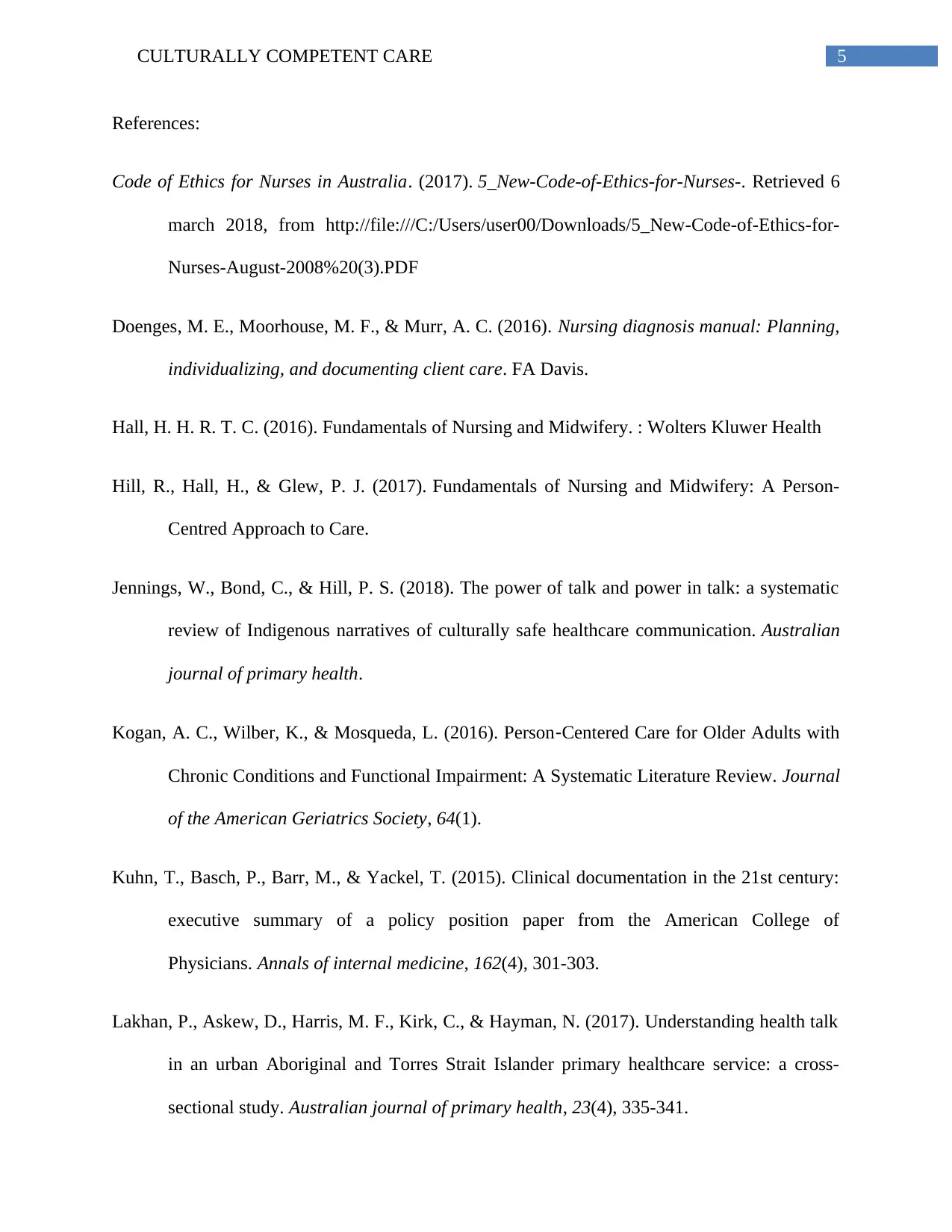
5CULTURALLY COMPETENT CARE
References:
Code of Ethics for Nurses in Australia. (2017). 5_New-Code-of-Ethics-for-Nurses-. Retrieved 6
march 2018, from http://file:///C:/Users/user00/Downloads/5_New-Code-of-Ethics-for-
Nurses-August-2008%20(3).PDF
Doenges, M. E., Moorhouse, M. F., & Murr, A. C. (2016). Nursing diagnosis manual: Planning,
individualizing, and documenting client care. FA Davis.
Hall, H. H. R. T. C. (2016). Fundamentals of Nursing and Midwifery. : Wolters Kluwer Health
Hill, R., Hall, H., & Glew, P. J. (2017). Fundamentals of Nursing and Midwifery: A Person-
Centred Approach to Care.
Jennings, W., Bond, C., & Hill, P. S. (2018). The power of talk and power in talk: a systematic
review of Indigenous narratives of culturally safe healthcare communication. Australian
journal of primary health.
Kogan, A. C., Wilber, K., & Mosqueda, L. (2016). Person‐Centered Care for Older Adults with
Chronic Conditions and Functional Impairment: A Systematic Literature Review. Journal
of the American Geriatrics Society, 64(1).
Kuhn, T., Basch, P., Barr, M., & Yackel, T. (2015). Clinical documentation in the 21st century:
executive summary of a policy position paper from the American College of
Physicians. Annals of internal medicine, 162(4), 301-303.
Lakhan, P., Askew, D., Harris, M. F., Kirk, C., & Hayman, N. (2017). Understanding health talk
in an urban Aboriginal and Torres Strait Islander primary healthcare service: a cross-
sectional study. Australian journal of primary health, 23(4), 335-341.
References:
Code of Ethics for Nurses in Australia. (2017). 5_New-Code-of-Ethics-for-Nurses-. Retrieved 6
march 2018, from http://file:///C:/Users/user00/Downloads/5_New-Code-of-Ethics-for-
Nurses-August-2008%20(3).PDF
Doenges, M. E., Moorhouse, M. F., & Murr, A. C. (2016). Nursing diagnosis manual: Planning,
individualizing, and documenting client care. FA Davis.
Hall, H. H. R. T. C. (2016). Fundamentals of Nursing and Midwifery. : Wolters Kluwer Health
Hill, R., Hall, H., & Glew, P. J. (2017). Fundamentals of Nursing and Midwifery: A Person-
Centred Approach to Care.
Jennings, W., Bond, C., & Hill, P. S. (2018). The power of talk and power in talk: a systematic
review of Indigenous narratives of culturally safe healthcare communication. Australian
journal of primary health.
Kogan, A. C., Wilber, K., & Mosqueda, L. (2016). Person‐Centered Care for Older Adults with
Chronic Conditions and Functional Impairment: A Systematic Literature Review. Journal
of the American Geriatrics Society, 64(1).
Kuhn, T., Basch, P., Barr, M., & Yackel, T. (2015). Clinical documentation in the 21st century:
executive summary of a policy position paper from the American College of
Physicians. Annals of internal medicine, 162(4), 301-303.
Lakhan, P., Askew, D., Harris, M. F., Kirk, C., & Hayman, N. (2017). Understanding health talk
in an urban Aboriginal and Torres Strait Islander primary healthcare service: a cross-
sectional study. Australian journal of primary health, 23(4), 335-341.
⊘ This is a preview!⊘
Do you want full access?
Subscribe today to unlock all pages.

Trusted by 1+ million students worldwide
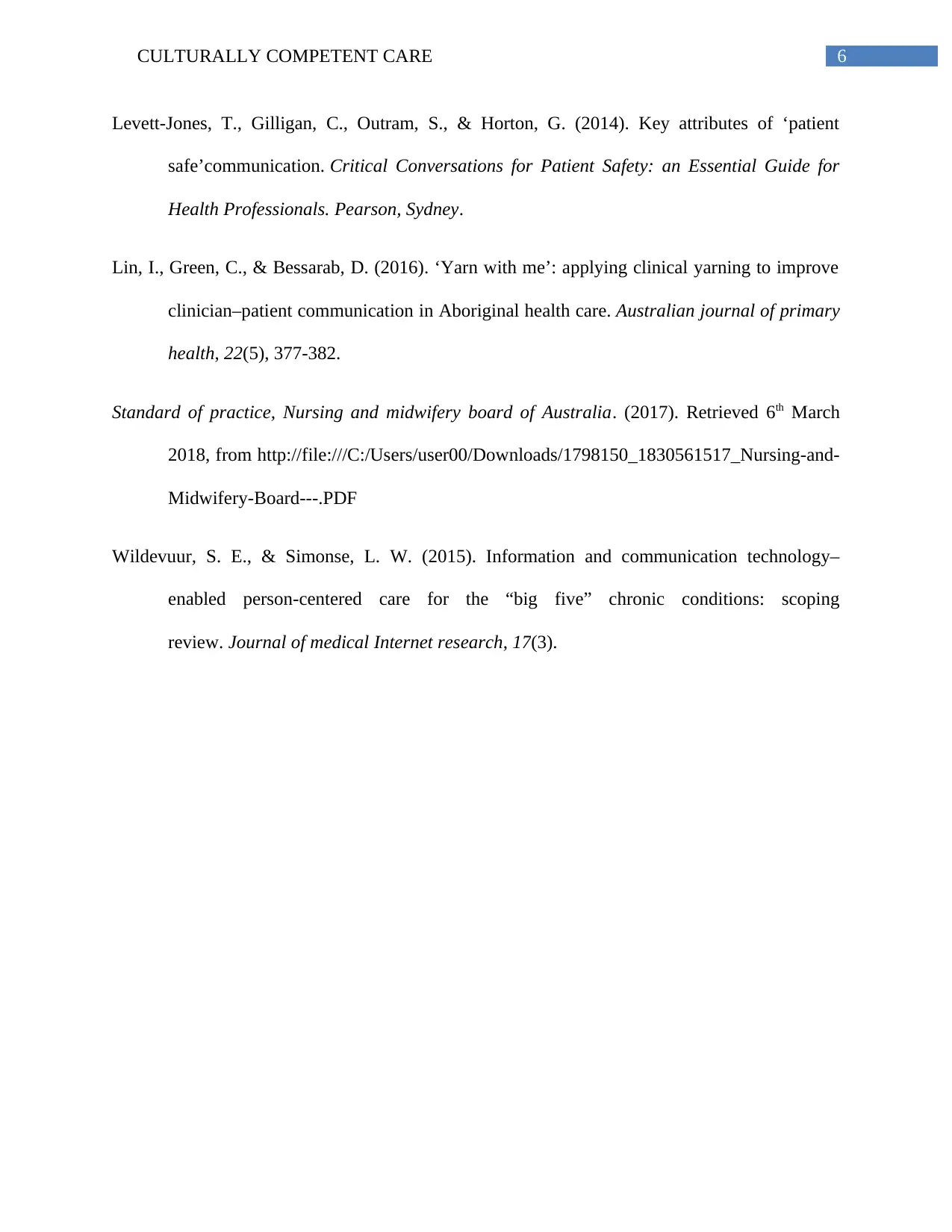
6CULTURALLY COMPETENT CARE
Levett-Jones, T., Gilligan, C., Outram, S., & Horton, G. (2014). Key attributes of ‘patient
safe’communication. Critical Conversations for Patient Safety: an Essential Guide for
Health Professionals. Pearson, Sydney.
Lin, I., Green, C., & Bessarab, D. (2016). ‘Yarn with me’: applying clinical yarning to improve
clinician–patient communication in Aboriginal health care. Australian journal of primary
health, 22(5), 377-382.
Standard of practice, Nursing and midwifery board of Australia. (2017). Retrieved 6th March
2018, from http://file:///C:/Users/user00/Downloads/1798150_1830561517_Nursing-and-
Midwifery-Board---.PDF
Wildevuur, S. E., & Simonse, L. W. (2015). Information and communication technology–
enabled person-centered care for the “big five” chronic conditions: scoping
review. Journal of medical Internet research, 17(3).
Levett-Jones, T., Gilligan, C., Outram, S., & Horton, G. (2014). Key attributes of ‘patient
safe’communication. Critical Conversations for Patient Safety: an Essential Guide for
Health Professionals. Pearson, Sydney.
Lin, I., Green, C., & Bessarab, D. (2016). ‘Yarn with me’: applying clinical yarning to improve
clinician–patient communication in Aboriginal health care. Australian journal of primary
health, 22(5), 377-382.
Standard of practice, Nursing and midwifery board of Australia. (2017). Retrieved 6th March
2018, from http://file:///C:/Users/user00/Downloads/1798150_1830561517_Nursing-and-
Midwifery-Board---.PDF
Wildevuur, S. E., & Simonse, L. W. (2015). Information and communication technology–
enabled person-centered care for the “big five” chronic conditions: scoping
review. Journal of medical Internet research, 17(3).
1 out of 7
Related Documents
Your All-in-One AI-Powered Toolkit for Academic Success.
+13062052269
info@desklib.com
Available 24*7 on WhatsApp / Email
![[object Object]](/_next/static/media/star-bottom.7253800d.svg)
Unlock your academic potential
Copyright © 2020–2025 A2Z Services. All Rights Reserved. Developed and managed by ZUCOL.




